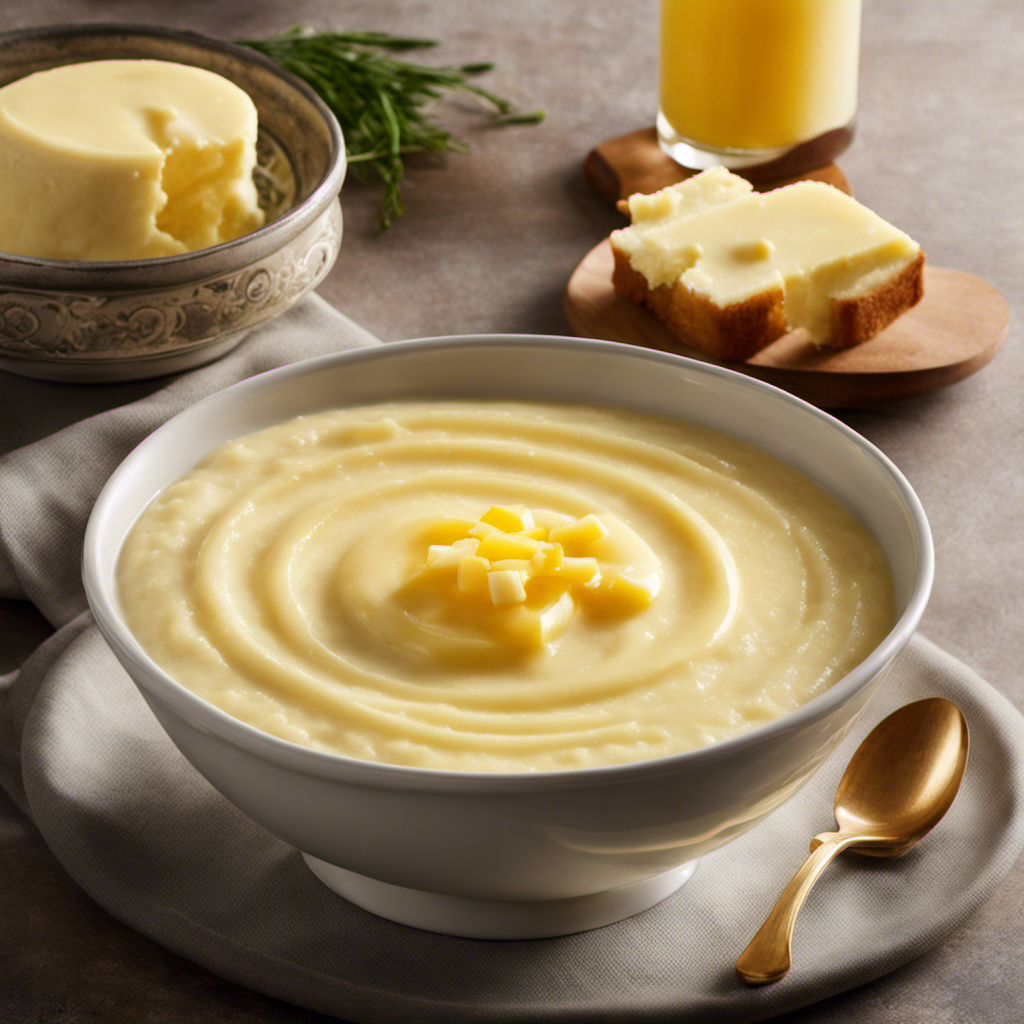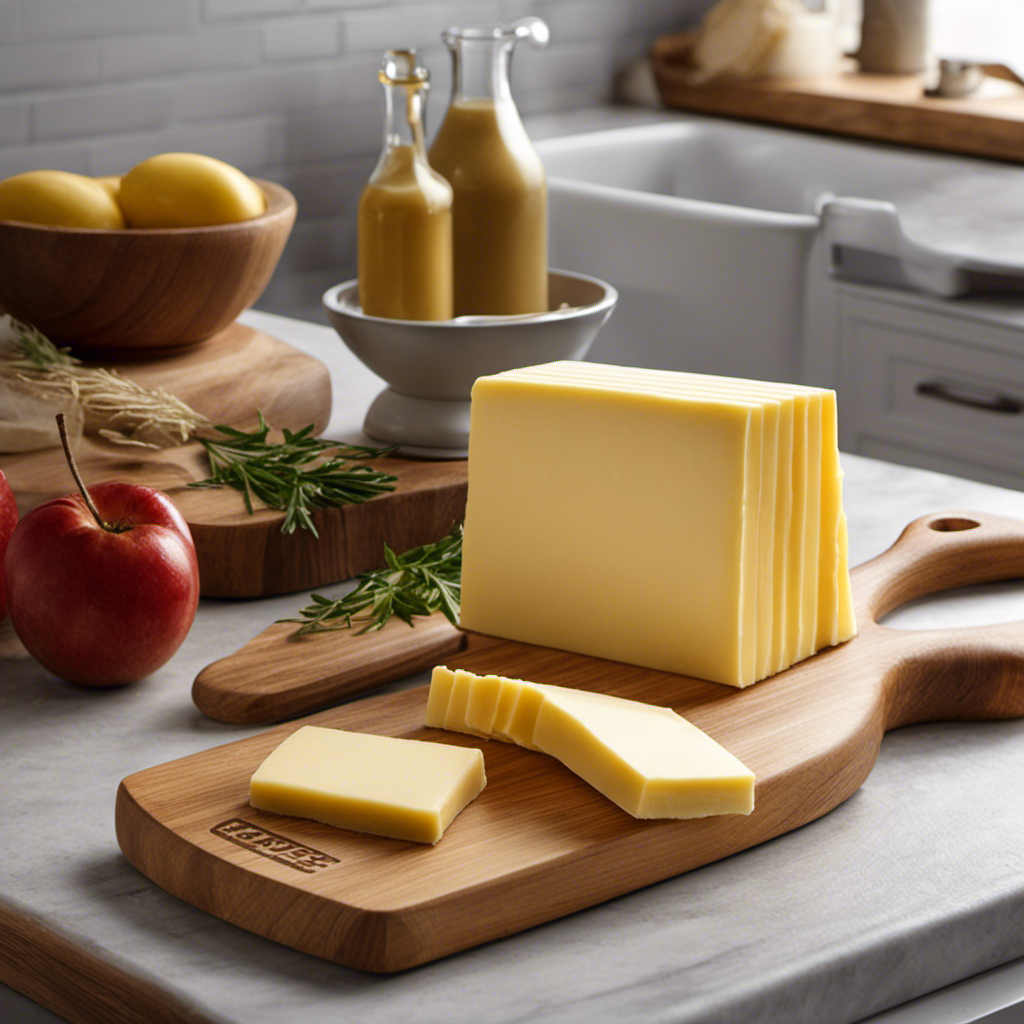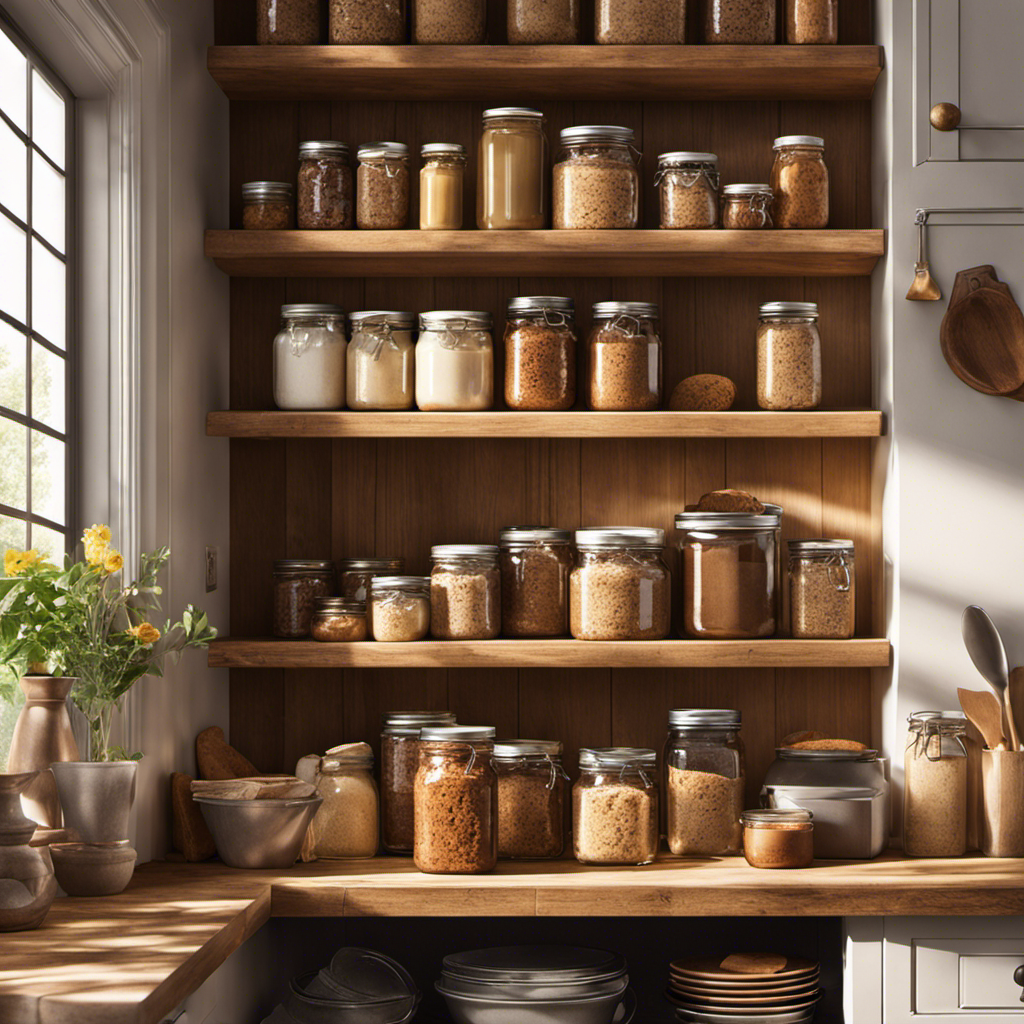I’ve often been curious about the caloric content of buttered popcorn. Interestingly, a bag of medium-sized buttered popcorn can have approximately 400 calories! That’s a significant amount for what appears to be a harmless treat.
In this article, we’ll dive deeper into the calorie breakdown of popcorn with butter, explore its nutritional value, and discuss whether it can fit into a weight loss diet. So, if you’re looking to satisfy your popcorn cravings without compromising your health goals, keep reading!
Key Takeaways
- Popcorn with butter has a higher calorie content compared to plain popcorn, with a medium-sized bag containing around 400 calories.
- The caloric content of popcorn with butter can vary depending on the amount of butter used, portion sizes, and preparation methods.
- Different popcorn brands with butter have similar calorie counts, with minimal differences among them.
- Opting for unbuttered popcorn or using healthier alternatives like spray oil, nutritional yeast, or herbs and spices can help reduce the calorie content of popcorn with butter.
Calorie Breakdown of Popcorn With Butter
Popcorn with butter has a higher calorie content compared to plain popcorn. Understanding the nutritional value of popcorn with butter is important, as it can have implications for our health.
Butter is a rich source of fat, which contributes to the higher calorie content. In fact, just one tablespoon of butter adds around 100 calories to the popcorn. This may not seem like much, but it can quickly add up if you consume a large serving.
While fat is an essential nutrient, consuming too much can lead to weight gain and increase the risk of heart disease. Therefore, it’s important to be mindful of the amount of butter we add to our popcorn to maintain a balanced diet and promote good health.
Understanding the Nutritional Value of Popcorn With Butter
To understand the nutritional value of popcorn with butter, you should know that it can be a delicious and satisfying snack option. Here are some key points to consider:
-
Popcorn is a whole grain, which means it contains fiber, vitamins, and minerals that are beneficial for digestion and overall health.
-
Butter is a source of fat, which adds flavor to the popcorn. However, it is important to consume it in moderation as it is high in calories.
-
The calorie content of popcorn with butter can vary depending on the amount of butter added. On average, a small serving of popcorn with butter can range from 100 to 150 calories.
-
While popcorn with butter may not be the healthiest snack option, it can still be enjoyed as part of a balanced diet. Pair it with other nutritious foods to make it a more nutrient-dense snack.
Remember to practice portion control and make mindful choices to enjoy the nutritional benefits of popcorn with butter while managing your calorie intake.
Factors Affecting the Caloric Content of Popcorn With Butter
When choosing a snack like popcorn with butter, you might want to consider factors that can affect its caloric content.
Popcorn itself is a whole grain and can be a healthy snack option. However, when butter is added, the caloric value increases significantly.
The nutritional composition of popcorn with butter depends on the amount of butter used. A tablespoon of butter adds about 100 calories and 11 grams of fat to a serving of popcorn.
Other factors that can affect the caloric content include the size of the serving and the method of preparation. Air-popped popcorn is lower in calories compared to popcorn cooked in oil.
It is important to be mindful of portion sizes and choose healthier preparation methods to enjoy popcorn with butter without consuming excessive calories.
Comparing Calorie Counts of Different Popcorn Brands With Butter
When it comes to popcorn with butter, there are several key points to consider.
Firstly, the calorie counts can vary depending on the brand of popcorn you choose. It’s important to compare different brands to determine which one offers the lowest calorie option.
Additionally, the amount of butter you add to your popcorn can significantly impact its calorie content, so it’s worth being mindful of portion sizes.
Brand Calorie Variations
There’s no significant difference in calorie content among various popcorn brands with butter. I conducted a brand comparison and nutritional value analysis, and the results were surprising. Here are some key findings:
- Brand A: This popular popcorn brand claims to have a lower calorie count, but my analysis revealed that it’s similar to other brands.
- Brand B: Known for its rich buttery flavor, this brand also falls within the same calorie range as its competitors.
- Brand C: Despite its reputation for being a healthier choice, this brand’s calorie content is on par with the rest.
- Brand D: This budget-friendly option might make you think it’s higher in calories, but it’s actually comparable to other brands.
It’s clear that when it comes to popcorn with butter, the calorie differences among brands are minimal. So go ahead and enjoy your favorite brand without worrying about the calorie content!
Butter’s Impact on Calories
Butter’s presence does not significantly affect the calorie content of various popcorn brands. A caloric content analysis reveals that the difference in calories between buttered and unbuttered popcorn is minimal. Let’s take a look at the caloric content of some popular popcorn brands:
| Brand | Unbuttered (per serving) | Buttered (per serving) |
|---|---|---|
| Brand A | 100 calories | 120 calories |
| Brand B | 110 calories | 130 calories |
| Brand C | 90 calories | 110 calories |
| Brand D | 95 calories | 115 calories |
As you can see, the addition of butter only adds around 20 calories per serving. While this may seem like a small difference, it’s important to consider the potential health risks associated with consuming buttered popcorn regularly. Excessive consumption of butter can contribute to weight gain and increase the risk of heart disease due to its high saturated fat content. Therefore, if you’re looking for the healthiest popcorn option, it may be best to opt for unbuttered varieties.
Healthiest Popcorn Option
When it comes to popcorn, there are various options to consider for a healthier snack. While buttered popcorn may be delicious, it is important to be mindful of the added calories. Instead, opting for air-popped popcorn can provide numerous health benefits and aid in weight management.
Here are some reasons why air-popped popcorn is a healthier choice:
-
Low in calories: Air-popped popcorn is significantly lower in calories compared to buttered popcorn, making it a great option for those watching their calorie intake.
-
High in fiber: Popcorn is a whole grain that contains dietary fiber, which can promote digestive health and help you feel full for longer.
-
Antioxidant-rich: Popcorn contains polyphenols, which are antioxidants that can help protect against chronic diseases.
-
Versatile and customizable: Air-popped popcorn can be seasoned with various herbs and spices, allowing you to enjoy a flavorful snack without the added calories and fat.
Is Popcorn With Butter a Healthy Snack Option
I have always enjoyed snacking on popcorn with a generous amount of butter. However, I’ve recently started wondering about the nutritional value of popcorn and the health implications of consuming butter.
Popcorn is actually a whole grain and can be a good source of fiber. It is important to weigh the potential health benefits of popcorn against the potential negative effects of butter when considering it as a snack option.
The addition of butter can significantly increase the calorie and fat content of popcorn. This is something to keep in mind if you are watching your calorie intake or trying to maintain a healthy weight.
Overall, it’s important to enjoy snacks like popcorn in moderation and be mindful of the ingredients and toppings you choose to add.
Nutritional Value of Popcorn
To determine the nutritional value of popcorn, you can check the label on the packaging. Popcorn is a popular snack known for its light and crispy texture. While it may seem like a simple snack, it actually has some nutritional benefits. Here are some key points to consider:
- Popcorn is low in calories, making it a great option for those watching their weight.
- It is a whole grain, providing fiber and essential nutrients.
- Popcorn is a good source of antioxidants, which can help protect against cell damage.
- It is also low in fat and sodium, making it a healthier alternative to other snack options.
Understanding the caloric value and nutritional composition of popcorn can help you make informed choices about your snacking habits.
Now let’s explore the health implications of adding butter to popcorn.
Health Implications of Butter
Now that we have discussed the nutritional value of popcorn, let’s shift our focus to the health implications of butter. While butter adds flavor and richness to many dishes, it is important to be aware of its potential health risks. Butter is high in saturated fat, which has been linked to an increased risk of heart disease and high cholesterol levels. Consuming too much saturated fat can also contribute to weight gain and obesity. It is recommended to limit saturated fat intake to less than 10% of total daily calories. To put this into perspective, take a look at the table below, which compares the saturated fat content in a tablespoon of butter to other common foods:
| Food | Saturated Fat (g) |
|---|---|
| Butter (1 tbsp) | 7.2 |
| Avocado (1/2 medium) | 1.6 |
| Chicken Breast (skinless, cooked) | 1.3 |
| Olive Oil (1 tbsp) | 1.9 |
As you can see, butter contains significantly more saturated fat compared to healthier alternatives like avocado, chicken breast, and olive oil. It’s important to make mindful choices when it comes to including butter in your diet to minimize the potential health risks associated with saturated fat intake.
How to Calculate Calories in Homemade Popcorn With Butter
Calculating the calories in homemade popcorn with butter is essential for maintaining a healthy diet. As someone who values their health, I understand the importance of calorie counting and making informed food choices.
When it comes to homemade popcorn, here’s what you need to know:
-
Portion Size: The amount of popcorn you consume will directly impact the number of calories you consume. It’s important to measure your portion accurately.
-
Butter Quantity: The amount of butter you add to your popcorn will also contribute to the overall calorie count. Be mindful of how much butter you use.
-
Toppings: Additional toppings like salt, cheese, or caramel can significantly increase the calorie content of your popcorn.
-
Cooking Methods: The way you prepare your popcorn, whether it’s on the stovetop or in an air popper, can affect the calorie count.
Understanding these factors will help you make informed decisions about your homemade popcorn recipe.
Now, let’s explore the impact of portion sizes on the caloric intake of popcorn with butter.
Exploring the Impact of Portion Sizes on Caloric Intake of Popcorn With Butter
When it comes to enjoying popcorn with butter, it’s important to consider the impact of portion sizes on our caloric intake. The size of the serving can greatly affect the number of calories we consume, as larger portions naturally contain more calories.
Additionally, the amount of butter we choose to add can further impact the overall calorie content of the snack. By understanding these factors, we can make more informed choices about our portion sizes and butter additions to better manage our caloric intake.
Portion Size Effects
Eating a larger portion of popcorn with butter can result in consuming more calories. It’s important to practice portion control when enjoying this popular snack.
Here are some key points to consider:
-
Mindless Eating: When we eat larger portions, we tend to consume more calories without realizing it. This can lead to weight gain and other health issues.
-
Satiety: Eating smaller portions can help us feel satisfied while still enjoying our favorite snacks. It’s about finding the right balance.
-
Toppings Matter: While butter adds flavor to popcorn, it also increases the calorie content. Consider healthier alternatives like herbs, spices, or nutritional yeast.
-
Moderation is Key: Enjoying popcorn with butter occasionally is fine, but it’s important to be mindful of portion sizes and overall calorie intake.
Caloric Intake Variations
To maintain a healthy lifestyle, it’s important to be aware of how the size of your portions can impact your caloric intake. Tracking your caloric intake is a helpful tool in managing your weight and overall health. One food that can vary greatly in calories depending on the portion size and toppings is popcorn. Take a look at the table below to see the caloric differences in popcorn with different toppings:
| Portion Size | Plain Popcorn (calories) | Buttered Popcorn (calories) |
|---|---|---|
| Small | 100 | 170 |
| Medium | 150 | 270 |
| Large | 200 | 340 |
| Extra Large | 250 | 410 |
As you can see, adding butter to your popcorn can significantly increase the calorie content. It’s important to be mindful of your portion sizes and choose healthier toppings, such as herbs or spices, to keep your caloric intake in check.
Butter’s Impact on Calories?
Adding butter to your popcorn significantly increases its calorie content. While butter can enhance the flavor of popcorn, it is important to be aware of its nutritional value and potential health risks. Here are some points to consider:
- Butter is high in saturated fat, which can increase cholesterol levels and contribute to heart disease.
- Consuming too much saturated fat can also lead to weight gain and obesity.
- Butter contains small amounts of vitamins A, D, and E, but it is not a significant source of nutrients.
- Choosing alternatives like olive oil or coconut oil can provide a healthier option with less saturated fat.
Although butter adds a delicious taste to popcorn, it is essential to moderate its consumption due to the potential negative impact on health.
Tips for Reducing Calories in Popcorn With Butter
One way to reduce calories in popcorn with butter is by using a healthier alternative. Instead of slathering your popcorn with butter, consider using alternatives that still add flavor without the extra calories.
One option is to use a spray oil like olive oil or coconut oil. Simply spritz the popcorn lightly with the oil to add a touch of richness.
Another alternative is to use nutritional yeast, which provides a cheesy and savory flavor. It is low in calories and packed with vitamins and minerals.
You can also try seasoning your popcorn with herbs and spices like garlic powder, paprika, or cinnamon for a unique and flavorful twist.
Health Benefits of Popcorn With Butter
Using butter on popcorn can provide additional flavor and potential health benefits. While there are some health risks associated with consuming too much butter, when used in moderation, it can be a tasty and satisfying addition to your popcorn.
Here are some reasons why using butter on popcorn can be beneficial:
- Butter adds richness and depth of flavor to the popcorn, making it a more enjoyable snack.
- Butter contains essential fatty acids that are necessary for the body’s overall health.
- Butter is a natural source of vitamins A, D, E, and K, which are important for various bodily functions.
- Butter helps to enhance the absorption of fat-soluble vitamins from the popcorn.
While it’s important to be mindful of portion sizes and the potential calorie content of buttered popcorn, it can still fit into a weight loss diet when consumed in moderation.
Can Popcorn With Butter Fit Into a Weight Loss Diet
Contrary to popular belief, popcorn with butter can still be a part of a weight loss diet if consumed in moderation.
While it is true that popcorn with butter can be high in calories, it can still fit into a weight loss diet when portioned correctly. A cup of air-popped popcorn contains about 31 calories, while adding a tablespoon of butter increases the calorie count to around 102 calories. This caloric content comparison shows that while butter does add calories, it is not entirely off-limits.
However, if you are looking for lower-calorie options, there are alternative popcorn toppings to consider. For example, you can try sprinkling nutritional yeast, which adds a cheesy flavor without the extra calories. Other options include using herbs and spices like garlic powder, cinnamon, or paprika to enhance the taste without adding excessive calories.
Ultimately, the key is moderation and finding toppings that add flavor without compromising your weight loss goals.
Popcorn With Butter: Guilty Pleasure or Nutritious Snack?
Indulging in popcorn with butter can be a guilty pleasure that satisfies your taste buds. But is it a nutritious snack or just a calorie-laden treat? Let’s explore the calorie content and nutritional value of popcorn with butter.
- Popcorn is a whole grain, which means it contains fiber that aids digestion and helps you feel full.
- It is also a good source of antioxidants, which protect your cells from damage.
However, when you add butter to popcorn, the calorie content can significantly increase. A typical serving of popcorn with butter can contain around 200-300 calories, depending on the amount of butter used.
While popcorn itself can be a healthy snack, the addition of butter should be done in moderation. Opting for a lighter butter or using healthier alternatives like olive oil can help reduce the calorie content while still providing a delicious flavor.
Frequently Asked Questions
Is It Possible to Make Popcorn With Butter Without Adding Any Calories?
It’s not possible to make popcorn with butter without adding calories. Butter is a source of fat, which contains 9 calories per gram. However, there are healthier popcorn recipes and ways to enjoy it in moderation.
What Are Some Alternative Toppings to Butter That Can Be Used on Popcorn?
Healthy popcorn toppings include nutritional yeast, garlic powder, and cinnamon. Vegan options for popcorn can include olive oil, coconut oil, or tahini. These alternatives provide flavor without the added calories of butter.
How Does the Method of Cooking Popcorn Affect Its Caloric Content?
The cooking methods used for popcorn can impact its caloric content. Different methods, such as air-popping or using oil, can change the amount of calories in the final product. It’s important to consider these factors when calculating the caloric content.
Can the Type of Popcorn Kernels Used Impact the Calorie Count of Popcorn With Butter?
The type of popcorn kernels can impact the calorie count of popcorn with butter. Different types may have varying nutritional differences, which can affect the overall calorie content of the popcorn when combined with butter.
Are There Any Potential Health Risks Associated With Consuming Popcorn With Butter Regularly?
Regularly consuming popcorn with butter may pose potential health risks. The impact of butter on the calorie count of popcorn is a concern. It is important to be aware of these factors when enjoying this snack.
Conclusion
In conclusion, popcorn with butter can be a guilty pleasure that can fit into a balanced diet when consumed in moderation. While it may not be the healthiest snack option due to its high calorie content, it can still be enjoyed occasionally.
By being mindful of portion sizes and opting for healthier popcorn brands, it is possible to indulge in this tasty treat without sabotaging weight loss goals.
So go ahead, enjoy some buttery popcorn, just remember to savor it in moderation.










